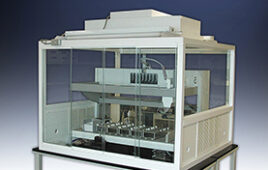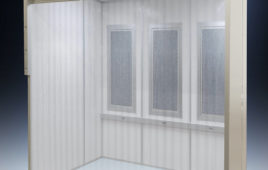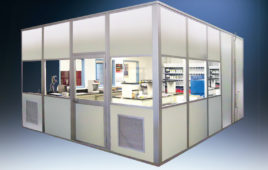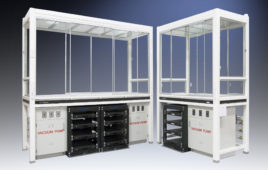For the fifth year, Controlled Environments surveyed its readership on cleanroom facility-related purchasing decisions, as well as the salary and benefits of cleanroom industry professionals. We have used these results to analyze the latest trends, which will enable you to compare your cleanroom and overall compensation package with those of your peers. We also asked questions about industry salaries, workloads, benefits and job satisfaction.
Pharmaceutical field takes the top spot
We asked our readers about the primary field of work performed in their facilities. Pharmaceuticals easily took the top spot, at 32.43 percent. A tie for second, at 12.16 percent, was held by Academic/Research and Biotechnology/Bioscience/Biologicals/Biomedical. The next-highest field represented, at 9.46 percent, was Medical Device/ Instrumentation/Electronics. Food and Beverage Processing came in at 6.76 percent. Clean Manufacturing Materials (Chemicals, Gases, Water, Solids) and Delivery Systems was selected by 5.41 percent of survey takers, as was Packaging. Aerospace/Homeland Security/Defense was represented by 2.7 percent of the audience, and Semiconductors, ICs, Hybrid Circuits, Sensors made up 1.35 percent.
“Other” responses totaled 12.16 percent—the open-ended answers included responses such as cleanroom testing, cosmetic manufacturing, sterilization, contamination control products and chemicals.
Facilities, equipment and supplies
We asked readers about the condition of the facilities in which they work. This year, 45.07 percent of survey takers said they work in a new or custom-built facility—nearly identical to last year at 45.7 percent. Meanwhile, 36.62 percent said they work in a retrofitted facility, compared to 40 percent in 2018. Turnkey facility workers made up 18.31, up from last year’s response of 14.3 percent.
Major repair/renovation of existing cleanroom facility is planned by 18.84 percent of those surveyed in 2019, compared to 28 percent in 2018 and 20.5 percent in 2017. Inspection by an outside company will be undertaken by 15.94 percent of 2019 survey takers, a big dip from 27 percent in 2018.
Meanwhile, 20.29 percent of responders of those surveyed are looking to build an entirely new cleanroom facility, consistent with 21 percent in 2018, and up from 12.3 percent in 2017 and 18.1 percent in 2016.
Another upward trend—those who will do a complete overhaul of their existing cleanroom facility, at 20.29 percent, up from 14 percent in 2018, 4.8 percent in 2017 and 12 percent in 2016. Responders were given a list of cleanroom supplies and asked to select everything that their facility purchases. This year, consumables retook the top spot at 73.24 percent—up from 65 percent in 2018, 69.9 percent in 2017, 80 percent in 2016 and 74 percent in 2015. Attire, last year’s top category, was down to 66.2 percent, compared to 69.9 percent in 2018.
Monitoring/instrumentation systems came in at 50.7 percent, down a bit from last year at 55.3 percent. Critical cleaning products came in at 53.52 percent—a jump from both 52.4 percent in 2018 and 49.3 percent in 2017. Furniture climbed a few percentage points to 56.34 percent in 2019, compared to 48.5 percent in 2018. Benches/ enclosures totaled 47.89 percent this year, up from 43.7 percent last year. Cleanroom services (outside cleaning companies, consultants, designers/engineers, etc.) stayed consistent at 43.66 percent this year, compared to 43.7 percent in 2018.
The majority of responders—61.64 percent—use single-use, disposable cleanroom attire. This is an interesting trend from years past, where single-use attire responders came in at 50.5 percent in 2018 and 40.8 percent in 2017. Washable attire use was 32.88 percent, similar to last year’s figure of 31.1 percent. Single-use, recyclable attire users continue to drop—5.48 percent in 2019, compared to 31.1 percent in 2018 and 7.5 percent in 2017.
We also asked readers who takes care of cleaning their facility. Most readers—47.22 percent—said that the cleanroom workers themselves perform cleaning duties, which is up from 42.7 percent in 2018 and 36.1 percent in 2017. An outside cleaning company is hired by 29.17 percent of survey takers, up from 27.2 percent in 2018 but down from 36.1 percent in 2017. A total of 23.61 percent of responders have an in-house staff dedicated to cleaning duties, down from 30.1 percent in 2018 and 27.8 percent in 2017.
Demographics
The vast majority of Controlled Environments readers who responded to this survey are men, at 87.3 percent of responders, as in previous surveys.
Unlike previous years, where one age group clearly dominated the workforce, this year’s survey showed a fairly even split between the four age groups we offered in our poll options—23.81 percent are under age 40, 26.98 percent are in the 40 to 49 age bracket, 25.4 are aged 50 to 59, and 23.81 percent are over age 60.
We also asked our readers about their company’s annual sales revenue, and 40.98 percent responded that they work for a company that brings in $25 million or less. Meanwhile, 21.31 percent said that their company has an annual sales revenue of $25 to $100 million; 14.75 percent work for companies in the $100 to $500 million range; and 22.95 percent work for a company that brings in more than $500 million per year.
Salary and responsbilities
A slight majority of survey takers, at 31.75 percent, do not supervise anyone. Supervisors with five or fewer people under them represent 30.16 of survey takers; 11.11 percent each answered that they supervise six to 10 employees and 10 to 20 employees; and 15.87 are in charge of more than 20 employees.
The trend of increasing workloads continued into 2019, with 79.03 percent of responders saying that the demands of their jobs have increased within the past year. Workloads remained steady for 14.52 of responders, and 6.45 percent said that their job demands have decreased in the past year.
Similar to last year, a little over half of our survey takers reported getting some kind of increase in pay or benefits in the past year, whether it was a “standard” or “considerable” performance-based raise, or a cost-of-living raise. About 9.5 percent of responders said they were rewarded in the form of a stronger benefits package, or they were given more incentive-based opportunities for cash rewards. A total of 20.63 percent said they received no type of salary increase whatsoever.
In a separate question, 79.37 percent said they have not faced any salary or benefits cuts in the past year, which is up from 70.9 percent in 2019.
When asked if their company offers adequate opportunities for growth, 60.32 percent said yes, up from 48.2 percent in 2018 and 53.8 percent in 2017.
Overall happiness
For the second year, we asked readers if they are looking for new jobs and why. Consistent with last year’s results, 40.32 percent said that they are happy in their current position and are therefore not seeking new employment. Meanwhile, 29.03 percent admitted that they’re looking simply out of curiosity, compared to 36.5 percent last year; 19.35 percent responded that they are actively seeking a new job, up from 15.3 percent in 2018.
Interestingly, 11.29 percent said that while they’re unhappy in their current position they are not looking to switch jobs at the moment, a figure that’s up from 8.2 percent last year.
For those who responded that they are looking for a new job, we asked them why. A better commute/more flexible hours was the top answer this year, as selected 21.15 of responders, up from 14.5 percent last year. Unhappiness with their current salary/benefits package was cited by 11.54 percent of survey takers, a big fall from 27.6 percent in 2018.
Another 9.62 percent said that they are bored and looking for a change, nearly identical to last year’s 9.2 percent.
Finally, those who say that they are unhappy with their current management/coworkers came in at 13.46 percent, a jump from 6/6 percent in 2018.
We also asked our readers if they plan to pursue a management position within their industry, and 47.62 percent responded that they are while 17.46 percent said that they are not, and 34.92 percent replied that they already hold a management position.
References
- 2015 Cleanroom Trends and Salary Survey: https://bit.ly/2tyNVaN
- 2016 Cleanroom Trends and Salary Survey: https://bit.ly/2yO27lj
- 2017 Cleanroom Trends and Salary Survey: https://bit.ly/2KbJDAw
- 2018 Cleanroom Trends and Salary Survey: https://bit.ly/2YIux8r




